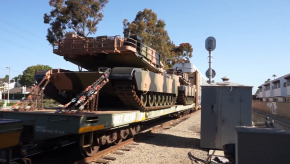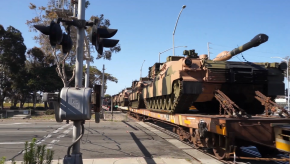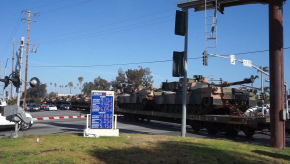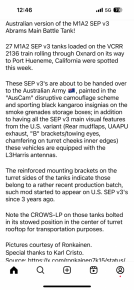Bases….Wonder what other capabilities they can cut out?
Extract from todays Australian newspaper.
The army will get up to $44bn to transform into an amphibious-capable force modelled on the US Marines, while the air force receives up to $33bn over the decade.
The plan includes $14bn to $18bn for missile defence systems, but was unclear on whether already-announced ballistic-defence and medium-range air-defence programs would continue as originally planned.
The blueprint includes $300m over the next four years for new drone and counter-drone systems, while a newly announced $1bn will be spent over the forward estimates to fast-track delivery of land-fired precision strike missiles, and underwater autonomous vehicles including the in-development Ghost Shark.
The army will get up to $44bn to transform into an amphibious-capable force modelled on the US Marines, while the air force receives up to $33bn over the decade.
The plan includes $14bn to $18bn for missile defence systems, but was unclear on whether already-announced ballistic-defence and medium-range air-defence programs would continue as originally planned.
The blueprint includes $300m over the next four years for new drone and counter-drone systems, while a newly announced $1bn will be spent over the forward estimates to fast-track delivery of land-fired precision strike missiles, and underwater autonomous vehicles including the in-development Ghost Shark.
Looks like we've gone from leasing to owning. I guess good and bad. We have some extra training capability, but the capability gap remains wide open for our helicopter force.
UK sells surplus H135 military helicopters to Australia.
UK sells surplus H135 military helicopters to Australia.
StevoJH
The Bunker Group
Well that probably partly paid for the 6 slightly larger H145's the UK just bought to base in Cyprus and Brunei.Looks like we've gone from leasing to owning. I guess good and bad. We have some extra training capability, but the capability gap remains wide open for our helicopter force.
UK sells surplus H135 military helicopters to Australia.
An article from Kym Bergman in todays Australia with his summation of how things are panning out for MBTs in Ukraine and suggesting that going forward IFVs may end up being more valued than MBTs for a range of reasons not the least in have an infantry crew that can provide protection and support.
extract.
What Ukraine has found to be of greater military value are donated Infantry Fighting Vehicles (IFV) such as the US Bradley and especially the Swedish CV 90. While a Western MBT typically approaches 70 tonnes in weight, IFVs are about half that – making them much more manoeuvrable, easier to conceal and use far less fuel. While the 120mm smoothbore gun on an MBT can destroy any vehicle they find, the 30mm and 40mm autocannons on IFVs are no slouches either – and if they can fire a quick burst, they can cripple most targets.
Another advantage is that IFVs typically carry a squad of six to eight soldiers each, who can exit the vehicle and form a screen around it as protection from enemy troops using short range ATGWs. MBTs rely on infantry separately deploying to support them, which is a complication in many rapidly evolving battlefield scenarios.
With this experience, Ukraine has pushed the donation of more IFVs to the top of their priority list – and in the medium term hopes to build 1000 CV 90s with the co-operation of the Swedish government. While MBTs still have a role – particularly to safeguard against a major Russian breakthrough – they are often relegated to the role of mobile artillery rather than spearheading offensive operations.

 apple.news
apple.news
extract.
What Ukraine has found to be of greater military value are donated Infantry Fighting Vehicles (IFV) such as the US Bradley and especially the Swedish CV 90. While a Western MBT typically approaches 70 tonnes in weight, IFVs are about half that – making them much more manoeuvrable, easier to conceal and use far less fuel. While the 120mm smoothbore gun on an MBT can destroy any vehicle they find, the 30mm and 40mm autocannons on IFVs are no slouches either – and if they can fire a quick burst, they can cripple most targets.
Another advantage is that IFVs typically carry a squad of six to eight soldiers each, who can exit the vehicle and form a screen around it as protection from enemy troops using short range ATGWs. MBTs rely on infantry separately deploying to support them, which is a complication in many rapidly evolving battlefield scenarios.
With this experience, Ukraine has pushed the donation of more IFVs to the top of their priority list – and in the medium term hopes to build 1000 CV 90s with the co-operation of the Swedish government. While MBTs still have a role – particularly to safeguard against a major Russian breakthrough – they are often relegated to the role of mobile artillery rather than spearheading offensive operations.
Ukraine conflict shows the limitations of Main Battle Tanks — The Australian
Credible analysis shows that since Russia’s unprovoked invasion of Ukraine in February 2022, the aggressor has lost more than 3000 Main Battle Tanks (MBTs) – with that figure increasing daily.
John Fedup
The Bunker Group
Currently the advantage seems to be with the drones. New cage protection for MBTs is underway which will help. It is much to soon to write off MBTs. There is undoubtedly a $hitload of R&D on anti-drone defence going on. An effective solution will return the MBT to the forefront again.An article from Kym Bergman in todays Australia with his summation of how things are panning out for MBTs in Ukraine and suggesting that going forward IFVs may end up being more valued than MBTs for a range of reasons not the least in have an infantry crew that can provide protection and support.
extract.
What Ukraine has found to be of greater military value are donated Infantry Fighting Vehicles (IFV) such as the US Bradley and especially the Swedish CV 90. While a Western MBT typically approaches 70 tonnes in weight, IFVs are about half that – making them much more manoeuvrable, easier to conceal and use far less fuel. While the 120mm smoothbore gun on an MBT can destroy any vehicle they find, the 30mm and 40mm autocannons on IFVs are no slouches either – and if they can fire a quick burst, they can cripple most targets.
Another advantage is that IFVs typically carry a squad of six to eight soldiers each, who can exit the vehicle and form a screen around it as protection from enemy troops using short range ATGWs. MBTs rely on infantry separately deploying to support them, which is a complication in many rapidly evolving battlefield scenarios.
With this experience, Ukraine has pushed the donation of more IFVs to the top of their priority list – and in the medium term hopes to build 1000 CV 90s with the co-operation of the Swedish government. While MBTs still have a role – particularly to safeguard against a major Russian breakthrough – they are often relegated to the role of mobile artillery rather than spearheading offensive operations.

Ukraine conflict shows the limitations of Main Battle Tanks — The Australian
Credible analysis shows that since Russia’s unprovoked invasion of Ukraine in February 2022, the aggressor has lost more than 3000 Main Battle Tanks (MBTs) – with that figure increasing daily.apple.news
Takao
The Bunker Group
Got to love a bloke who doesn't understand a fundamental Army truth writing about tanks.An article from Kym Bergman in todays Australia with his summation of how things are panning out for MBTs in Ukraine and suggesting that going forward IFVs may end up being more valued than MBTs for a range of reasons not the least in have an infantry crew that can provide protection and support.
extract.
What Ukraine has found to be of greater military value are donated Infantry Fighting Vehicles (IFV) such as the US Bradley and especially the Swedish CV 90. While a Western MBT typically approaches 70 tonnes in weight, IFVs are about half that – making them much more manoeuvrable, easier to conceal and use far less fuel. While the 120mm smoothbore gun on an MBT can destroy any vehicle they find, the 30mm and 40mm autocannons on IFVs are no slouches either – and if they can fire a quick burst, they can cripple most targets.
Another advantage is that IFVs typically carry a squad of six to eight soldiers each, who can exit the vehicle and form a screen around it as protection from enemy troops using short range ATGWs. MBTs rely on infantry separately deploying to support them, which is a complication in many rapidly evolving battlefield scenarios.
With this experience, Ukraine has pushed the donation of more IFVs to the top of their priority list – and in the medium term hopes to build 1000 CV 90s with the co-operation of the Swedish government. While MBTs still have a role – particularly to safeguard against a major Russian breakthrough – they are often relegated to the role of mobile artillery rather than spearheading offensive operations.

Ukraine conflict shows the limitations of Main Battle Tanks — The Australian
Credible analysis shows that since Russia’s unprovoked invasion of Ukraine in February 2022, the aggressor has lost more than 3000 Main Battle Tanks (MBTs) – with that figure increasing daily.apple.news
The advantage of having an infantry section integral to armour with an IFV is very true - which is why tanks fight with IFVs. FFS, combined arms is a basic building block because the advantages of one system outweigh the disadvantages of another. And honestly? infantry/armour is the oldest pairing in time.
Going into some details, but IFV size v MBT size? Please. I can't find a photo of an AS21 beside an M1, but Boxer is longer, slightly wider and slightly shorter than AS21. Note which is the second smallest vehicle in this photo?
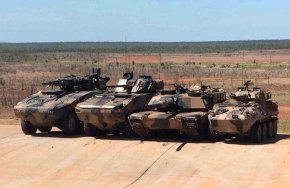
As for performance, generally speaking the M1 has the best power:weight ratio with the gas turbine offering unparalleled acceleration capability. For a fuel bill that, following lots of work, matches the Leopard 2 and honestly? Is probably going to be similar to Boxer or AS21. They are heavy beasties, both are closer to 2/3 of an M1 as opposed to the claimed 1/2. Note also that comes with a protection level that is quite impressive - while you may M-Kill a tank with a 30mm cannon, it is highly unlikely you'll K-Kill one from the front. An IFV though? Chances are that ATGM or 30mm is going through.
Rapidly evolving battlefield scenarios. Pfft. Wellington would recognise combined arms tactics.
And speaking of Wellington's tactics, the 'oh my, tanks are mobile artillery' is exactly how the Australian Army has always seen tanks. Yes, the Brits, Germans, Soviets and American's planned great tank-on-tank battles. For us, the infantry has always been the Corps of decision (because it's the only thing in the entire world that can take and hold terrain). As such, the tank has always been seen as support to the infantry - call it mobile artillery. Yes, our crews will shoot the T-xx or Type xx MBT if possible. And if our REDFOR uses the same stupid tactics the Russians do in Ukraine, we might explicitly plan tank-on-tank attacks. But that's not likely.
Wish I could get paid for smearing on a piece of paper and submitting it....
Bluey 006
Active Member
This is a positive "Australian Army to bring locally made lethal drone 'the Owl' into service within months".
This is mildly concerning
"Defence industry insiders say while they are pleased the Innovaero Owl is proceeding, they warn there have been lengthy delays imposed on other so-called urgent innovation programs because of a lack of funding to progress contracts".
This is mildly concerning
"Defence industry insiders say while they are pleased the Innovaero Owl is proceeding, they warn there have been lengthy delays imposed on other so-called urgent innovation programs because of a lack of funding to progress contracts".
GMARS – Global Mobile Artillery Rocket System
Rheinmetall and Lockheed Martin developed GMARS as a solution for the growing demand for long-range rocket artillery.
GMARS, potential for Australia to acquire? Can take…
12 GMLRS/ER
or
4 PRSM
or
2 ATACMS
or
LRASM integrating.
Last edited:
Redlands18
Well-Known Member
The Emu War is unlike any other Australian battle film you've ever seen - ABC News
Coming to a theatre near you, an epic war film about the Australian Army at its finest.
Gallipoli: no
Western Desert: no
Kokoda: no
Long Tan: no
But against the greatest foe the Army has ever known
The Emu
Coming to a theatre near you, an epic war film about the Australian Army at its finest.
Gallipoli: no
Western Desert: no
Kokoda: no
Long Tan: no
But against the greatest foe the Army has ever known
The Emu
Australia’s first 27x M1A2 SEPv3 tanks are en route.
Observed last week in California prior to delivery…
Observed last week in California prior to delivery…
Attachments
-
1.7 MB Views: 69
-
1.8 MB Views: 69
-
1.7 MB Views: 68
Redlands18
Well-Known Member
U.S. Army Conducts First Anti-Ship Ballistic Missile SINKEX using PrSM - Naval News
The US has conducted a SINKEX using two PrSM missiles against the former USS Cleveland (LPD-7). They were fired from an Autonomous Multi-Domain Launcher mounted on a HIMARS. As a partner in the PrSM program and a future HIMARS operator and having a requirement for a land based AShM capability, this could be where Australia is headed.
The US has conducted a SINKEX using two PrSM missiles against the former USS Cleveland (LPD-7). They were fired from an Autonomous Multi-Domain Launcher mounted on a HIMARS. As a partner in the PrSM program and a future HIMARS operator and having a requirement for a land based AShM capability, this could be where Australia is headed.
The Australian stated there was not any active protection for its armoured vehicles I don't believe this to be correct with the Rafael Iron Fist to be mounted on both the Redback and Boxers
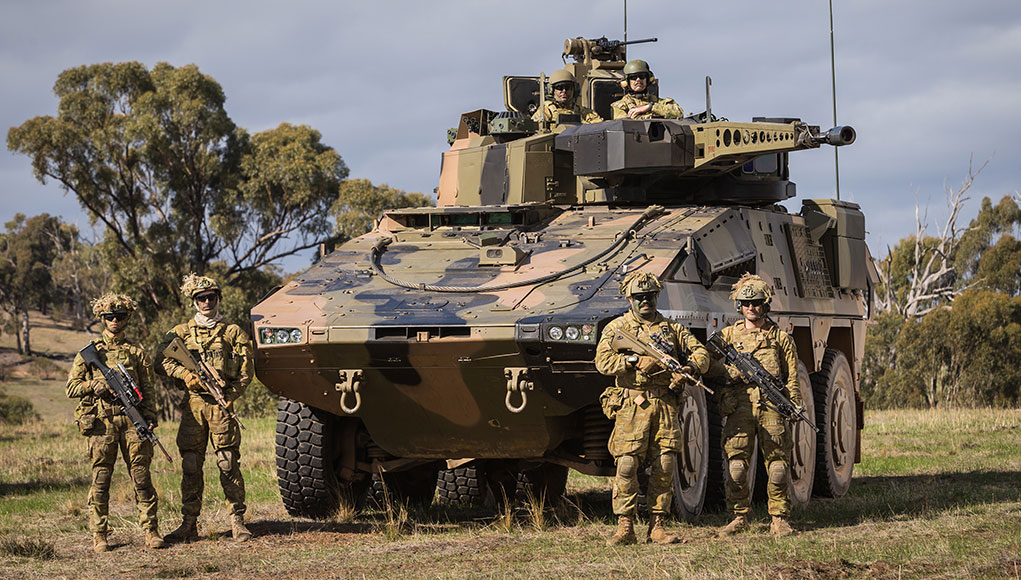
 defense-update.com
This earlier article from Cove discusses attacks from above on tanks by drones ,somewhere there will be a lot of research done on countering such drones ,but for now these thousands of drones expended every week appear to have thrown pre war doctrine out the window
defense-update.com
This earlier article from Cove discusses attacks from above on tanks by drones ,somewhere there will be a lot of research done on countering such drones ,but for now these thousands of drones expended every week appear to have thrown pre war doctrine out the window

Iron Fists APS for the Australian Boxers - Defense Update:
The Australian Defence Force has asked Rheinmetall Defence to evaluate Israel's Iron Fist Active Protection System (APS) developed by Elbit Systems' IMI. Brigadier Greg McGlone, Australian Army Director General, Armored Fighting Vehicles, broke the news at the International Armoured vehicles...
I suspect as with the SPIKE LR2 launch system (in which around 40x launchers are to be acquired for the 137x odd turreted Boxer CRV's we are buying), most Redback and Boxer CRV's will be "fitted for but not with" Iron Fist APS (and the Kongsberg RWS) and there will be a pool of such systems available for specific training / deployment requirements as necessary.The Australian stated there was not any active protection for its armoured vehicles I don't believe this to be correct with the Rafael Iron Fist to be mounted on both the Redback and Boxers
This earlier article from Cove discusses attacks from above on tanks by drones ,somewhere there will be a lot of research done on countering such drones ,but for now these thousands of drones expended every week appear to have thrown pre war doctrine out the window
Iron Fists APS for the Australian Boxers - Defense Update:
The Australian Defence Force has asked Rheinmetall Defence to evaluate Israel's Iron Fist Active Protection System (APS) developed by Elbit Systems' IMI. Brigadier Greg McGlone, Australian Army Director General, Armored Fighting Vehicles, broke the news at the International Armoured vehicles...defense-update.com
I would not hold my breath waiting for the funding to be released to equip every land combat vehicle with such systems...
Redlands18
Well-Known Member
Hope they have put in some type of warning system for dismounted soldiers, though I doubt even hugging the ground is going to save someone who is directly beneath the explosion. That is the major drawback with these systems you are setting off an explosion that could cause casualties amongst your own troops.I suspect as with the SPIKE LR2 launch system (in which around 40x launchers are to be acquired for the 137x odd turreted Boxer CRV's we are buying), most Redback and Boxer CRV's will be "fitted for but not with" Iron Fist APS (and the Kongsberg RWS) and there will be a pool of such systems available for specific training / deployment requirements as necessary.
I would not hold my breath waiting for the funding to be released to equip every land combat vehicle with such systems...
Could the GMARS be a better option for Australia going forward, twice as many missiles carried compared to HIMARS. I don't think it would fit in a Herc though. Cheers. Rheinmetall, Lockheed unveil GMARS, in talks with European customers: Exec - Breaking DefenseU.S. Army Conducts First Anti-Ship Ballistic Missile SINKEX using PrSM - Naval News
The US has conducted a SINKEX using two PrSM missiles against the former USS Cleveland (LPD-7). They were fired from an Autonomous Multi-Domain Launcher mounted on a HIMARS. As a partner in the PrSM program and a future HIMARS operator and having a requirement for a land based AShM capability, this could be where Australia is headed.
Big_Zucchini
Well-Known Member
Hope they know how to fit those systems quickly, because that'll be the bottleneck for quick reaction deployment.I suspect as with the SPIKE LR2 launch system (in which around 40x launchers are to be acquired for the 137x odd turreted Boxer CRV's we are buying), most Redback and Boxer CRV's will be "fitted for but not with" Iron Fist APS (and the Kongsberg RWS) and there will be a pool of such systems available for specific training / deployment requirements as necessary.
I would not hold my breath waiting for the funding to be released to equip every land combat vehicle with such systems...
I strongly believe that for at least most APS nowadays, if the APS is in any way a threat to you as an infantryman, it's likely you'll eat an RPG to the face regardless.Hope they have put in some type of warning system for dismounted soldiers, though I doubt even hugging the ground is going to save someone who is directly beneath the explosion. That is the major drawback with these systems you are setting off an explosion that could cause casualties amongst your own troops.
How often are you going to fire so many missiles simultaneously that a full battery (or more) of M142 can't deliver? Ground launched munitions are far more expensive per kg of warhead than air launched munitions, any day of the week, and going for the Lockheed-exclusive M142 or GMARS is essentially that rule pushed further.Could the GMARS be a better option for Australia going forward, twice as many missiles carried compared to HIMARS. I don't think it would fit in a Herc though. Cheers. Rheinmetall, Lockheed unveil GMARS, in talks with European customers: Exec - Breaking Defense
Has anyone clearly defined the niche an Australian MRL is supposed to fill? I think Australia should at least push for integration rights on these platforms.
I realise defence stuff is expensive, but sometimes it is a false economy compromising platforms to such an extent.I suspect as with the SPIKE LR2 launch system (in which around 40x launchers are to be acquired for the 137x odd turreted Boxer CRV's we are buying), most Redback and Boxer CRV's will be "fitted for but not with" Iron Fist APS (and the Kongsberg RWS) and there will be a pool of such systems available for specific training / deployment requirements as necessary.
I would not hold my breath waiting for the funding to be released to equip every land combat vehicle with such systems...
We are spending billions on acquiring the Boxer in an age where we are seeing the modern use of armoured vehicles in peer on peer conflict.
We are seeing their attributes and vulnerabilities.
I’m pretty sure the decision to acquire such limited numbers of ATGM launchers was before the major escalation in Ukraine two years ago.
Time for a re think
Our limited numbers of armoured vehicles need to have the offensive and defensive systems from the get go.
Cav, IFV MBT need to be equiped to go when called
When called upon to go,it will be quick and without time to aquire and train with “ missing links “ that should already have been in service
A small army cannot afford such compromises
The fitted for but not with thing is a dated concept.
Time to reconsider and fund the requirement.
Cheers S

